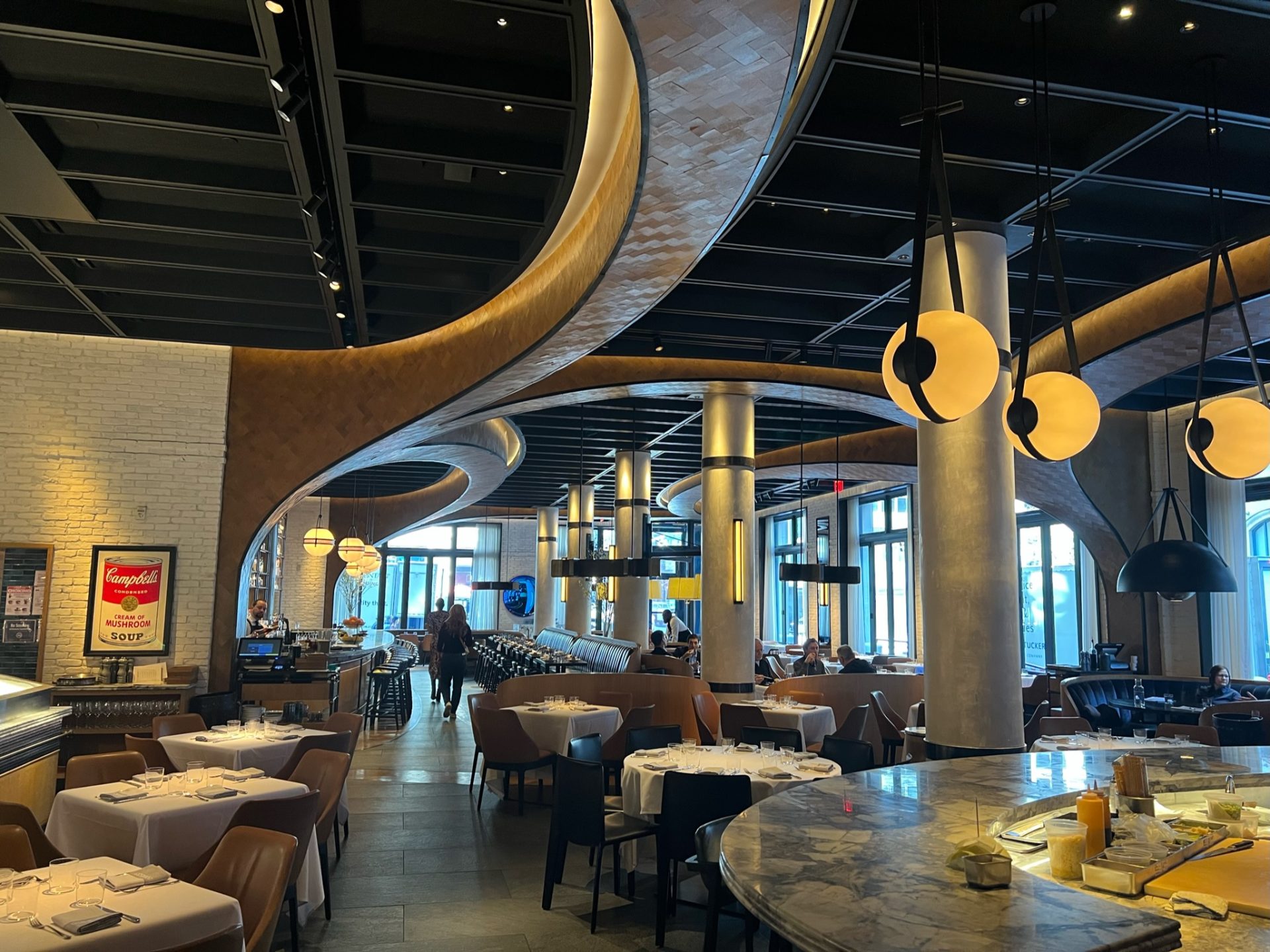Instagrammable Restaurants Islamabad: Picture-Perfect Dining Knowledge
Instagrammable Restaurants Islamabad: Picture-Perfect Dining Knowledge
Blog Article
Savor Genuine Asian Cuisine With a Pan-Asian Spin for a Culinary Experience
Beginning on a cooking trip via genuine Asian food, enhanced with a Pan-Asian spin, provides a special opportunity to discover the rich tapestry of flavors that specify the region's varied cooking practices. This experience welcomes you to relish the elegant equilibrium of preferences-- sweet, salty, spicy, and sour-- harmonized by fragrant herbs and spices. Think of the innovative fusion of Thai curry and ramen or the unforeseen joy of sushi burritos. As you ponder these attracting meals, think about the social narratives and historical impacts that form them, each bite providing a tale waiting to be discovered.

Checking Out Pan-Asian Flavors
In the world of worldwide gastronomy, Pan-Asian cuisine stands out for its remarkable diversity and the unified interplay of tastes from different Asian cultures. This culinary strategy celebrates the one-of-a-kind components and rich practices discovered across the continent, creating a tapestry of tastes that is both intriguing and rewarding. Secret to Pan-Asian food is its capacity to balance contrasting flavors-- sweet, salty, spicy, and sour-- while highlighting the freshness and top quality of each component.
From the umami-rich soy sauce of Japan to the fiery chili peppers of Thailand, Pan-Asian cuisine uses an extensive scheme of flavors. These components are usually integrated in innovative ways, enhancing meals with layers of intricacy. For example, the usage of fragrant herbs such as lemongrass and cilantro, common in Vietnamese and Thai cuisine, adds a refreshing illumination to dishes, while the incorporation of coconut milk provides a velvety, rich appearance.
The focus on fresh fruit and vegetables and aromatic seasonings makes certain that each dish is not just a banquet for the taste buds but likewise for the senses. Pan-Asian cuisine invites restaurants to begin on a culinary journey, checking out the large and varied landscapes of Asian gastronomy with every bite.
Fusion Meals to Try
While Pan-Asian food is commemorated for its conventional tastes, the modern-day cooking landscape is progressively embracing blend recipes that mix these timeless components with impacts from other areas. This cutting-edge technique not only honors the rich heritage of Asian cookeries yet also presents novel preference experiences that attract contemporary palates.
A prime example of such a combination dish is the Korean-Mexican taco, where seasoned bulgogi beef is wrapped in a cozy tortilla, topped with kimchi and a zesty gochujang-infused salsa. This combination weds the strong, mouthwatering tastes of Korea with the vibrant, fresh components of Mexican food. In a similar way, sushi burritos have actually gained appeal, integrating the fragile artistry of Japanese sushi with the hearty, hand-held convenience of a burrito, typically including combination ingredients like tempura shrimp and avocado with a drizzle of wasabi mayo.
Another noteworthy recipe is Thai curry ramen, which infuses the luscious, aromatic seasonings of Thai curry right into the calming brew of standard Japanese ramen, developing a harmonious blend that tantalizes the senses. These fusion meals expand past plain novelty; they stand for a cooking discussion in between societies, motivating expedition and innovation in the world of Pan-Asian cuisine.
Crucial Components and Seasonings
To genuinely appreciate Pan-Asian cuisine, one must comprehend the essential ingredients and seasonings that form its structure. This varied cooking style draws from an abundant tapestry of Asian practices, using an unified blend of flavors and structures. Secret ingredients include soy sauce, fish sauce, and oyster sauce, which give a full-flavored umami depth important to Asian recipes. Complementary to these are rice vinegar and mirin, lending a delicate level of acidity and sweetness.
Fragrant components are crucial, with garlic, lemongrass, and ginger being ubiquitous throughout numerous Pan-Asian recipes. These components provide a fragrant base that boosts the complexity of flavors. Spices such as celebrity anise, cardamom, and cinnamon present heat and personality, resembling influences from areas like China and India.

Food Preparation Methods and Tips
Understanding the art of Pan-Asian food requires knowledge with its distinctive food preparation strategies, each contributing to the vivid tapestry of tastes this culinary tradition is celebrated for. Central irish pub near me to these techniques is the stir-fry, a rapid cooking strategy that protects the nutritional honesty and vibrant shades of active ingredients. Making use of a frying pan, the stir-fry approach permits even warmth circulation, essential for attaining the characteristic structure and taste balance of Pan-Asian meals.
Another essential strategy is steaming, especially prevalent in Chinese food. This gentle method maintains the all-natural flavors and nutrients of active ingredients, making it excellent for fish and shellfish and veggies. Dumplings, a beloved staple, commonly take advantage of steaming, leading to soft, succulent structures.
Grilling, likewise important, presents smoky depths to dishes such as Oriental bulgogi or Japanese yakitori (Chinese food Islamabad). This strategy frequently entails marinading active ingredients, enabling flavors to permeate deeply prior to food preparation over an open fire or warmer
Finally, grasping the art of stabilizing flavors-- wonderful, sour, salted, bitter, and umami-- is critical. Effectively layering these aspects can raise a recipe from ordinary to phenomenal, offering a complicated and satisfying cooking experience that embodies the significance of Pan-Asian food.
Eating Experiences Worldwide
Across the globe, Pan-Asian food provides an unmatched eating experience, celebrated for its abundant tapestry of tastes and vivid presentations. This cooking sensation has transcended cultural limits, capturing the hearts and tastes buds of food fanatics worldwide. In cosmopolitan cities fresh York, London, and Sydney, Pan-Asian restaurants function as fusions where culinary traditions from Thailand, Japan, China, and past converge, providing diners with a diverse mix of meals that highlight the region's variety.
The global charm of Pan-Asian cuisine exists in its ability to provide both authenticity and advancement. Chefs skillfully wed standard ingredients such as lemongrass, soy sauce, and miso with modern techniques, leading to recipes that are both acquainted and refreshingly new. This fusion allows restaurants to begin on a culinary journey that values heritage while accepting modernity.
Furthermore, dining experiences are raised via attentively developed atmospheres that mirror the principles of Pan-Asian looks. From minimalist Japanese-inspired interiors to dynamic Thai-themed spaces, each dining establishment uses a special setting that complements the cooking offerings. Because of this, clients are not merely taking in a dish however partaking in a cultural experience, making Pan-Asian eating a genuinely global phenomenon.
Final Thought
The exploration of Pan-Asian cuisine offers a profound understanding of the intricate interaction of tastes and culinary customs throughout Asia. By accepting combination dishes such as Thai curry ramen and sushi burritos, the culinary journey not just highlights the versatility of traditional active ingredients but additionally Continued showcases ingenious modern strategies. This gastronomic journey, enhanced by necessary spices and cooking methods, provides a distinct opportunity to value the social variety and cooking artistry that specify Pan-Asian food on a worldwide scale.
Beginning on a culinary trip via genuine Oriental cuisine, enhanced with a Pan-Asian spin, offers a special chance to discover the rich tapestry of flavors that specify the area's diverse culinary practices.In the realm of international gastronomy, Pan-Asian food stands out for visit site its exceptional diversity and the harmonious interaction of tastes from different Oriental societies. Key to Pan-Asian cuisine is its ability to balance different flavors-- pleasant, salty, spicy, and sour-- while highlighting the freshness and high quality of each ingredient.

Report this page